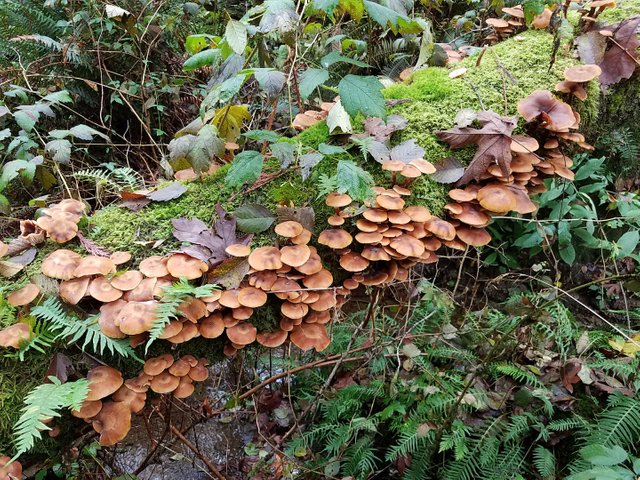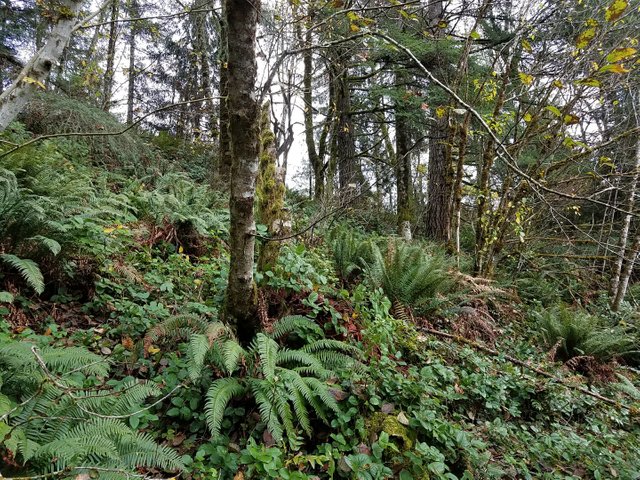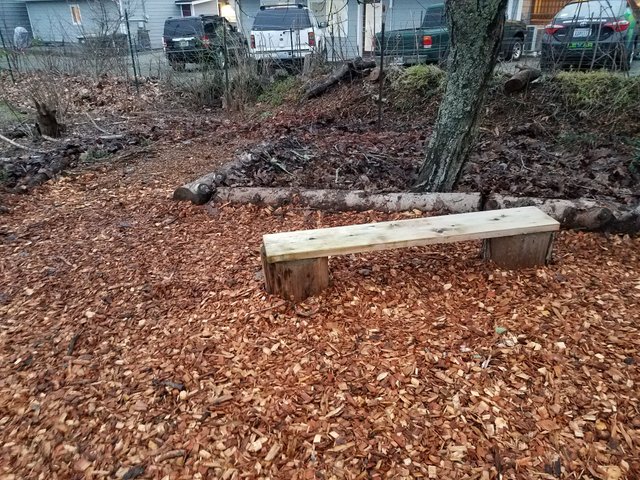The Wood Wide Web - Nature's Internet

Have you heard of the wood wide web? If not I'm sure you have seen the results of it--a vast community all interconnected sharing resources and even ideas. Sound familiar? But this is no human creation. This is nature's internet and it is the foundation behind our forests. Without this web it is unlikely that the forests (and other environments!) would be anything like they are today.
So what is the wood wide web?
The Wood Wide Web - An Overview
A couple months ago I wrote a short post about fungi and homesteading that mentioned the wood wide web but I thought this topic was important enough to warrant its own post.
The above video by the BBC really does a great job at condensing this complex subject into a few minutes--plus it has some nice animations :)
To summarize, the wood wide web could be defined as the network connecting trees and other plants together for communication (yes plants can "talk" more on that later), sharing resources, supporting the next generation, and sometimes fighting each other.
This network is used by the plants but is not created directly by them. Instead the wood wide web is made up of vast fungal strands.
How Plants Use the Wood Wide Web

When you look at a forest you may enjoy it but I doubt you ever heard the trees speaking. But surprisingly through the wood wide web trees and other plants can "talk".
When a tree or other plant is under attack from a pest it will often release chemicals both into the air and down into the wood wide web. These chemicals travel through the air and the fungal network where other plants pick up on them. These plants are then warned about the pest and can activate their defenses to hopefully keep the pests at bay.
These defenses might be increasing sap production, growing hairs on stems/leaves, or increasing production of toxic chemicals.
But plants also share resources such as water and sugars with each other through the wood wide web. Here in the Pacific Northwest it was shown that trees send resources to each other through the web--though cedar did not like to share.
Research has also shown that a "mother tree" will support their seedlings that are growing in the shade by sending them nutrients through the network.
You might be asking what the fungi get out of this since they form the network that the plants use. The fungi take some of the sugars the plants all produce as "payment" (could call it a tax). This keeps the fungi happy and in return the fungi create the network and also gather nutrients and water that plant roots can't get on their own and share the water and nutrients through the network.
To me what this all seems to indicate is that plants are adapted to live in diverse communities that are connected through this network. By sharing resources the plants help ensure the community survives. Since they depend on this community to thrive they are willing to "sacrifice" to keep the community going.
The plants are what we see on the surface but without this underground network most of our plants would struggle. The vast majority of plants (90%+) form some sort of relationship with fungi.
Why a Homesteader Should Care

I mulch a lot on my homestead--when my wife and I bought this land this area was all grass. Now it is starting to look like a forest.
As a homesteader or gardener you might be thinking this is all great but how does this affect my garden or homestead?The main way this directly impacts you by potentially helping you out by saving you time and energy and increasing your harvests.
But a lot of our common methods for gardening/homesteading actually degrade this fungal network which results in more work and more expense for you.
When you till the soil you are essentially cutting the fungal network. While the fungi can repair the network if you do this over and over again the network will fail.
Chemical fertilizers, herbicides, pesticides, and especially fungicides can all damage or kill the fungi needed for the network to exist.
But what you might not think about is what happens when you keep your different growing areas isolated from each other. Often people put a garden in one area, a few fruit trees in another, some berries in a different spot and the flower bed in another spot.
Between all of these a lot of people just have lawns.
While there will be some fungi moving through the lawn it really is not the best environment for fungi to thrive. You could think of these lawn areas as firewalls that are cutting off your different growing areas from each other.
What I recommend is to remove the grass with mulch (you can still have a designated lawn area--this is what I did on my homestead). Have your paths be mulched instead of grass and then plant all the areas outside of your paths.
If setup right the result will be that all your different growing areas will become interconnected through the fungal network--the wood wide web. You will have removed the firewalls.
If you do this and stop the practices that degrade the fungal network the result will be that the network will take some of the work load off your shoulders. Through the wood wide web your plants would be able to get access to water and nutrients from across your property instead of just in the relatively small area that their roots reach.
Plus your plants are likely to have less disease and pest issues and will likely be more productive.
And you will do less work--seems like a win win to me!
Of course it takes time for this network to develop. It might be a couple years before you notice the benefits. I think this is one reason why people use the methods that degrade the land. In the short run you can get big harvests but in the long run the land degrades and you end up doing more and more work to keep the plants going.
But with a little patience and understanding that the first few years might not be the best you can setup a system that lets you work with nature which will save you time, energy and money.
What do You Think?

The more fungi on my homestead the better!
So what are your thoughts on all of this? I know talking plants can seem a bit crazy but this is what the research seems to be indicating. It really is a lot like that movie Avatar--just with less shinny lights.
On my own homestead I was careful when I was designing my planting areas to make sure that it will be possible for the fungal network to reach all parts of my homestead with no "firewalls" cutting off access.
I'm also using mulch and other techniques like hugelkultur and placing snags/woody debris to create an environment that supports fungi. I'm also not tilling any spot more than once (at the start to get the site prepped for planting) and I'm not using any chemical pest control methods or chemical fertilizers.
We tend to focus on our plants but it is also very important to support the fungal network and the rest of the soil life if we truly want to work with nature instead of against it.
This really is what I mean when I talk about being a Wild Homesteader.
Thanks for reading this and please reply with your thoughts.

Weekly Blog Post
- What You Need to Know About Permaculture Zones
- Companion Post on Steemit - Getting Started With Permaculture Zones
Related Blog Posts
- How to Work With Nature to Rewild your Homestead (And Why You Should Do It.)
- Hugelkultur Beds: The Best Raised Beds for Your Garden
- What is Mulching? The Complete Introduction to Mulching
- 6 Methods for Preparing Land for Planting
- Control Garden Pests without Toxic Chemicals
Follow me for more posts all about homesteading, working with nature, and growing your own food: @wildhomesteading
And check out my blog - www.wildhomesteading.com for weekly in-depth posts on working with nature to grow your own food and start/build your homestead.
Congratulations @wildhomesteading! You have completed the following achievement on the Steem blockchain and have been rewarded with new badge(s) :
You can view your badges on your Steem Board and compare to others on the Steem Ranking
If you no longer want to receive notifications, reply to this comment with the word
STOPTo support your work, I also upvoted your post!
Vote for @Steemitboard as a witness to get one more award and increased upvotes!
Hi wildhomesteading,
Visit curiesteem.com or join the Curie Discord community to learn more.
Thank you! :)
This post is very informative. As student in ecology field I agree with your methods. The fungi and the rhizome bacteria are powerful natural agent to reconstruct and sustain the soil quality.
Thank you! :) I'm a restoration project manager with an ecology and hydrology background so this is an area I get excited about! Thanks for the comment!
Hey @wildhomesteading thank you for your imformative post.
I had to laugh when I saw world wide wood web but then it made me just stunned. Maybe we can learn way more from nature as we think.
I think treating the nature as one of our most valuable ressource would be the best way to go to keep our planet healthy :)
I am looking forward to your next post
Yeah, it was a surprise to me too when I first learned about it. I think there is a lot that nature can teach us and if we work with nature there is a lot we can accomplish. I believe that by working with nature we can move beyond just minimizing our impact to actually having a net positive impact where our actions make the natural world even more abundant than it might have been without human engagement. But we still have a ways to go in that regard.
Thanks for the comment!
So lovely and inspirational, thanks for sharing.
Thank you! :)
Wooaw such an amazing way to tell the story of these fungus in a connection of nature. I really love your amazing concept and I enjoyed every second in there. Each word there was worth the time and I hope to meet more great works from your end soon.
lovely piece and keep the nature spirit up
Posted using Partiko Android
Thank you! :) Really good to hear that you enjoyed the post!
You are humbly welcome
Posted using Partiko Android
Thanks for bringing this up @wildhomesteading, as I didn't have a clue about trees forming such a network. I was really surprised after watching the BBC video in your post.
Especially trees warning each other, sounds fantastic.
Very interesting comparison :) It sure makes me understand the subject better. I can imagine creating firewalls between "nodes" is not what you want in your garden. I guess everyone who is doing this is not aware of these facts.
Well the last time I saw a talking tree was in Lord of the Rings :D But giving a thought about these facts, it is not weird at all. The nature is simply fabulous and there is so much we can learn about it.
Thanks again for this interesting post!
Thanks! Yeah, I was having a little fun using internet comparisons but I do think it helps people understand the fungal networks.
It really is amazing how much is happening that we just don't tend to be aware of in our fast paced lives. Perhaps Tree Beard was right... "Don't be hasty" could be a good motto to live by if we want to truly appreciate everything that is happening in nature.
Thanks for the comment!
It made me understand the fungal networks better indeed! Nice technique to make it understandable :)
100% agreed! :)
I have always loved mushrooms, but I did not know the fungus was up to so much with the trees ... this also explains why I feel more alive where there is so much more life going on ... forests and big parks where the soil is often mulched and not as much disturbed. I really appreciated this article and will resteem it so others get the word!
Thank you! :) I feel the same way in areas with more life :)
I'm so glad to see this article here, there are not many like this.
You're very right about that. When I first saw the title, I thought it's a joke as I know nothing about this. I'm learning, my dad has a garden and I'm helping and learning but I'm far from knowing what it's necessary. We have a big garden for vegetables and three smaller ones for fruits, divided, unfortunately. We're learning and using new methods every year though.
I'm going to follow you because I can learn a lot from you. These are very important things if we want to protect nature and it's time to wake up and do something good but first we have to learn how. Here comes in handy posts like yours! I hope you're going to keep posting and share your knowledge and experience with us.
Thank you! I'm very happy to hear that you found the post interesting and useful! I'm happy to keep sharing and I hope you continue to find my posts useful. Good luck with your garden!
Posted using Partiko Android
Thank you very much, I wish you the same.
Fascinating I have seen a documentary on this before an amazing discovery but makes perfect sense. Everything is truly connected and when we damage nature we are damaging ourselves, Wonderful talk, thanks for sharing. We have a lot to learn about trees and indeed how we can learn from them, I hope we do this before we destroy too many trees 💯🐒
Thanks and I'm glad that you found it all interesting. I hope we learn soon too!
Posted using Partiko Android
We are continually learning from our endeavours and to share them develops all those around us. 💯🐒